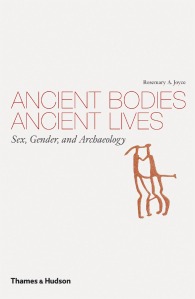Ancient Bodies, Ancient Lives is a book published in 2008 by Thames and Hudson. A product of my teaching an interdisciplinary course, “Archaeology of Sex and Gender”, in Berkeley’s Discovery Course program, the book is an experiment in making archaeological knowledge available to others interested in teaching about sex and gender, from anthropological, historical, archaeology, and gender studies perspectives. While examples from “the past” are sometimes brought into discussions in allied fields like anthropology or gender studies, and material histories are sometimes included with documentary histories, most archaeologists, myself included, complain that these uses misrepresent both what we know, and how we know, about past ways of being men and women. The power of the past to naturalize what we should question is something many feminist archaeologists, myself included, want to combat. I know from teaching hundreds of students from across the university that the best way to make others understand the power of the past, and its dangers, is to engage directly with primary materials. So the book project is paradoxical: it provides a single-authored text that has as its goal not to be simple straight-forward story-telling about the past, but rather, clear and compelling narrative about doing analysis of the material traces of past lives.
Subscribe:
RSS feed


Ann
July 26, 2010
This might interest you (if you haven’t heard about it already) but this new publication from INAH should have quite a bit of sexual identity stuff as well:
http://dti.inah.gob.mx/index.php?option=com_content&task=view&id=4487&Itemid=512
Weird
November 4, 2011
Hello 🙂
I am a student of prehistoric archaeology in Heidelberg, Germany. I am currently writing my thesis about identity and material culture, focusing somewhat on gender identities. I discovered this book by a lucky coincidence (if there’s any such thing) two days ago and ordered it immediately. Today, I am a little under the weather and decided to stop working for the day – and just then the mail arrived. After a quick glance into your book I nearly shouted “hurray”, and I’ll definitely work some more today, reading it! 🙂 It seems to be worth gold (is that a correct expression in English? Hope so…), and I am really looking forward to reading it. I can’t believe I found it only recently. Anyway – thank you for writing a book so promising, I am sure it will be of much, much help!
Cheers,
Weird
Rosemary Joyce
November 4, 2011
You know, this is exactly what I wrote the book for– people like you. Hope the thesis goes well, and feel free to post comments any time.
And by the way– wonderful website. I am sending info on it to a PhD student whose committee I am on who studies craft knitting. Meanwhile, you might find this article by Julia Hendon, in the Journal of Social Archaeology, of some interest; in it, she reconsiders textile arts as craft from the perspective of gender in archaeology:
Textile production as craft in Mesoamerica: Time, labor and knowledge
Weird
November 7, 2011
Thank you so much for your reply and the link! The approach sounds very interesting and plausible (from the abstract, I will have to read the full article later), and I am sure that, although I write about European/German prehistory, it will be helpful and probably transferable to at least some degree. I wasn’t aware of the journal you linked to, and once more I have the feeling of having struck gold. As I just discovered, I even have full access through our university library, I can hardly believe my luck! And there are so many intriguing articles there, I have to schedule extra reading time, I guess 🙂
Thank you for your kind words and for sending along info about our website, that really means a lot! If your student has a blog or website about knitting, I’d love to see it if you have the link!